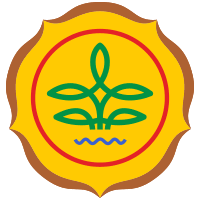Perbaikan Beberapa Sifat Kimia pada Tanah Pasca Tambang Batubara dengan Pemberian Dosis Bokashi Kiapu (Pristia stationes L.) dan Krinyu (Choromolaena odorata L.)
Abstract
Keywords
Full Text:
PDFReferences
APNAN. 1996. Pedoman Penggunaan EM bagi Negara-negara Asia- Pasifik Nature Agricultere Network (APNAN). Departemen pertanian, badan Pendidikan dan Latihan Pertanian. Jakarta.
Arinong, R. 2013. Fosfor Tanah. http://www.stppgowa.ac.id/infor masi/artikel-ilmiah/258-fosfor- tanah.htm 5 Juli 2018
Atmojo, S. W. 2003. Peranan Bahan Organik Terhadap Kesuburan Tanah Dan Upaya Pengelolaanya. Sebelas Maret University Press. Surakarta. 36 hlm.
Cooke J. A., and Jhonson M. S. 2002. Ecological Restoration of Land With Particularreference to the Mining of Metals and Industrial Minerals : A Review of the oryand Pratice. Environmental Review 10:41-71.
Djuarmani, N . Kristian, B.S Setiawan. 2005. Cara Cepat Membuat Kompos. Agromedia Pustaka. Jakarta.
Dodd WE, Louis AO. 2003. Evaluating Reclamation Success At Three AML Sites in North Dakota in 1998 and 2003. 25 th Annual Confrence of the Associaton of Abandoned Mine Land Program. Kentucky, 28 Sept-01Oct 2003.
Edy, S. H. 2008. Pembibitan kelapa sawit. Pusat Penelitian Kelapa Sawit. Medan.
Fredy, A., Ismayana, A., Indrasti, N. S., Suprihatin, Maddu, A. 2012. Factor rasio C/n Awal dan Laju Aerasi pada Proses Co- composting Bagasse dan Blateng. Fakultas Teknologi Pertanian IPB. Bogor. Volume 22 Nomer 3. Halaman 173 -179.
Foth, Henry D 1998. Dasar-dasar Ilmu Tanah. Terjemahan Purbayanti, E. D. dkk. Gajah Mada University Press, Yogyakarta.
Hakim, N, M.Y. nyapka, a. M. Lubus, S. G. Nugroho, M. R. Saul, M. A. diha, G. B. Hong, dan H. H. Bailey. 1986. Dasar- dasar Ilmu Tanah. Universitas Lampung. Lampung.
Halvin JL, Beaton DJ, Nelson SL, dan Nelson WL, 2005, 2005. Soil Fertility and Fertilizers.An Introduction toNutrient Management.NewJersey : Pearson Prentice Hall. Dalam Munawar, Ali. 20011. Kesuburan tanah dan Nutrisi Tanaman, IPB Press. Bogor.
Hardjowigeno. 2010. Ilmu Tanah. Rajawali Press. Bogor.
Kusumanintyas, Hapsari. 2009. Limonologi Tanaman Air. http://www.scribd.com/doc/55466421/Tanaman-Air-Di-GH
Kohnke H. 1968. Soil physics. New York: McGraw-Hill Book Company.
Lingga, P. dan Marsono. 2001. Petunjuk Penggunaan Pupuk. Penebar Swadaya. Jakarta. 163 hlm.
Munawar.2011. Kesuburan Tanah dan Nutrisi Tanaman.ITB Press. Bogor.
Nadapdap, E. F. R., Rauf, A., Hanafiah, A.S. 2013. Kajian Total Biomassa dan Simpanan Karbon Rerumputan Serta Sifat Fisika Kimia Tanah Pada Lahan Rerumputan Dengan Kelas Lereng Berbeda di Daerah Tangkapan Air Danau Toba. Jurnal. Fakultas Pertanian. Universitas Sumatera Utara. Medan. Vol 2, No.1.
Lubis, S. Y. Dkk. 2010. Dasar-dasar Ilmu Tanah. Universitas Lampung. Lampung.
Paul, E.A dan F.E.Clark. 1989. Soil Microbiology and Biochemistry. Academic Press, Inc. Harcourt Brace Jovanovich, Pulb. Toronto.
Sariwahyuni. 2002. Laju Penyerapan Logam Berat Cu, Cd, Co, dan Ni dengan penambahan Bahan Organik Ganggang Coklat Pada Tanah Bekas Penambangan Nikel Pomala. Univesitas Hasanudin. Makasar
Sugeng. 2006. Tanaman Apotik Hidup. Semarang : Aneka Ilmu.
Susanto, R. 2002. Penerapan Pertanian Organik. Kanisisus. Yogyakarta.
Subroto dan Yusrani. 2005. Kesuburan dan Penataan Tanah. Bayumedia Publishing. Malang.
Soniari , N.N., Budiyani, N.K,. dan Sutari, N.W.S. (2014). Analisis Kualitas Mikroorganisme Lokal (MOL). bonggolPisang. E- Jurnal Agroekoteknologi Tropika. Vol 5 (1): Universitas Udayana. Bali.
Subowo. 2011. Penambangan Sistem Terbuka Ramah Lingkungan dan Upaya Reklamasi Pasca Tambang Untuk Memperbaiki Kualitas Sumberdaya Lahan dan Hayati Tanah.Jurnal Sumberdaya Lahan Volume.5 No.2, Desember 2011. Bogor.
Prawiradiputra, B.R. 2007. Krinyu Chromolaena Odorata (L.)R.M.King dan H. Robinson: Gulma padang rumput yang merugikan. Bulletin Ilmu Peternakan Indonesia (WARTAZOA), 17(1):124-132
Novizan, 2005, petunjuk pemupukan yang efektif. Jakarta : Agro Media Pustaka
Rosmarkam, A., dan N. W. Yuwono2002. Ilmu Kesuburan Tanah. Kanisius.Yogyakarta.
Thamrin, m., S. Asikin, Mukhlis dan A. Budiman. 2007. Potensi ekstrak flora lahan rawa sebagai pestisida nabati. Dalam Supriyo, A., M. Norr, I. Ar-Riza dan D. Nazemi (Ed). Monograf : keanekaragaman Flora dan Buah-buahan Eksotik Lahan Rawa. Balai Besar Penelitian dan Pengembanga Sumberdaya Lahan Pertanian. Hal 23-31.
Utami, N.H., 2009. Kajian Sifat Fisik, Sifat Kimia dan Sifat Biologi Tanah Paska Galian C pada Tiga Tipe Penutupan Lahan. Departeman Silvikultur, Fakultas Kehutanan, Institut Pertanian Bogor. Bogor.
Wahida dan Suryaningsih Ni Luh Sri 2012. “Analisis kandungan unsur hara pupuk Organik cair di kabupaten Marauke”. Jurnal Agricola. Vol 6. No 1. p-ISSN : 2088-1673
Winarso, S. 2005. Kesuburan Tanah dan Strategi Pengelolaannya. Edisi Pertama. Graha Ilmu. Yogyakarta.
Wirdati dan Mardhatillah 2015, penentuan konsentrasiLogam berat Pb, Cu, Zn, dan Konduktivitas Listrik Limbah Cair Industri Pabrik Karet Pekanbaru : Karya Ilmiah FMIPA Binawidya Pekanbaru.
Yuniar.2002. Biologi Tanah dan Strategi Pengelolaannya. Edisi Pertama. Graha Ilmu. Yogyakarta.
Yulipriyanto, M. 2010. Biologi Tanah dan Penerapannya. Graha Ilmu, Jakarta.
DOI: http://dx.doi.org/10.35941/jatl.2.1.2019.2530.29-37
Refbacks
- There are currently no refbacks.
Copyright (c) 2019 Jurnal Agroekoteknologi Tropika Lembab







4.jpg)
.jpg)











